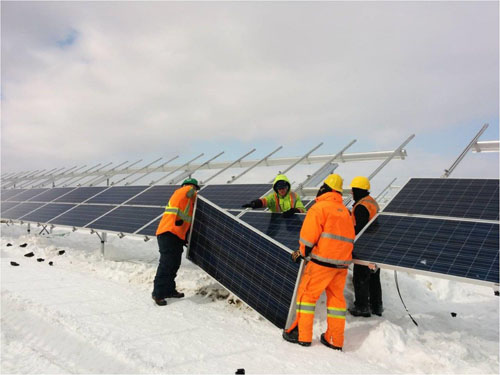Constructing Solar Solutions: In extreme winter conditions
 Although the imagery of solar power may conjure up thoughts of the summer sun fueling renewable energy, construction is a year-round industry and solar sites are no exception. Experienced solar builders are skilled in construction techniques for all seasons.
Although the imagery of solar power may conjure up thoughts of the summer sun fueling renewable energy, construction is a year-round industry and solar sites are no exception. Experienced solar builders are skilled in construction techniques for all seasons.
The Polar Vortex
Enter the winter of 2013-2014 and the bone-chilling villain, named Polar Vortex, which swept across Canada and a majority of the Eastern United States. Wikipedia defines this term as a persistent, large-scale cyclone that circles either of the planet’s geographical poles. It heralded extreme cold temperatures and snowfall, prompting countless automobile accidents, highway closures, flight delays, and school and business closures.
Many Toronto residents in Canada reported waking in the middle of the night, experiencing what felt like an earthquake. These tremors turned out to be ice quakes, which occur when rigid ice expands, building up tremendous pressure that results in cracking and large booming sounds.
Though countless construction projects fell behind schedule due to this extreme weather, many projects managed to continue on course, as a result of much ingenuity and perseverance—demonstrating that renewable solar energy can be created in the face of even the most extreme winter conditions.
Despite the bitter-cold temperatures and seemingly never-ending snow experienced in Ontario, several renewable energy teams pressed on in completing 14 solar projects during the Polar Vortex. However, completing this feat was no easy task. Teamwork was essential in what became somewhat of a man-versus-nature sense. The extreme weather forced the team to be creative in finding ways to persevere.
-
Meeting deadlines
These 14 solar projects each had definite end-dates, with the potential for considerable monetary penalties for those solar farms not going in-service on time and as planned. To maintain the schedules in extreme weather, it was imperative to organize for the winter conditions ahead of time.
Although the extreme of the Polar Vortex might not have been expected, planning for worst-case scenarios on a project site is always worth the effort. Knowing construction for these projects was to occur during the winter months, a step as small as ordering heating supplies for the site and for the workers beforehand was significant.
-
Setting the scene
Manpower productivity is reduced by 50% to 60% in extreme weather conditions. With sites as large as 100 acres, warming stations can never be too numerous or too close. Some of the solutions the solar teams dealing with the Polar Vortex employed include:
- Utilizing electrically heated winter jackets;
- Shuttling in school buses for those breaks and for relief from the cold;
- Warming up cables and heating rocks in a fire pit to keep close and warm; and
- Preparing for project duties ahead of time by warming tools and equipment, or clearing snow.
-
Preparing for snow
Snow removal is critical to constructing solar facilities in the winter, not only to maintain access throughout the site, but also to clear the modules for performance testing.
Being proactive is essential when it comes to dealing with snow at a solar site, so it’s important to be prepared for the first fall, lest it accumulate. Snow that’s left to sit or melt only compounds and can become more difficult to remove. With foresight, all materials, tools and supplies should be moved or elevated to avoid freezing or being buried and lost beneath the snow. If overnight flurries are predicted, it’s important to make sure preparations are made in advance to begin clearing for the workday ahead; even if this means clearing throughout the night.
Every site has its own unique challenges and snow removal capabilities. Because of this, individual site conditions should dictate the approach to snow removal. Some sites may focus on packing snow, while others might excel in scraping. Likewise, approaches to clearing panels are not always consistent. Different measures include: blowers mounted to front of skid steers; leaf blowers; compressed air blowers; and a variety of squeegees, brooms, and scrapers. Know what works best for the panels being installed.
Also, show consideration in the overall snow removal strategy selected. If snow that’s cleared onsite is piled, consider the implications when it melts. Try to relocate snow offsite if possible to limit melt-off. Careful planning will not only ensure a dryer, well-maintained site, but will also mean that neighboring properties won’t be washed out come spring.
A bright light in the midst of this peril: once panels are energized they will melt snow and ice!
-
Surveying the site
There’s no way around it, solar site surveying takes twice as long in winter months and technical difficulties can ensue during snowfall. The placement of survey pins becomes more complicated when dealing with snow and frozen soils. As permanent survey pins are drilled into the frozen ground, snow accumulation must be cleared to locate them.
The survey equipment itself can also experience challenges in frosty conditions. For one, extreme temperatures can cause LED screens to freeze. Secondly, although total station survey equipment is intended to operate at line of sight, note that it often doesn’t work during snowfall.
-
Being equipment-ready
It’s no surprise that equipment is often more difficult to get started in colder conditions. And, equipment that isn’t properly warmed up can be damaged. To keep battery-operated tools warm, they can be outfitted with thermal socks that are stuffed with chemical heat packs. Using insulated pipe sleeves around some specialty tools can also help.
-
Knowing the limits
With a collaborative team and strong field leadership, it’s clear that anything is possible project-wise, regardless of the weather. The Ontario solar teams who worked through blizzard conditions to complete multiple solar power projects are proof of that.
Trenching, for example, is a horrendous task in extreme winter weather and should be avoided at all costs if possible. It adds the additional step of first getting though frozen ground with a hoe ram just to break frost. Once that’s completed, often what’s left are piles of hardened, over-burdened material that’s not appropriate for trench backfill.
Although, it’s not always possible to accurately predict the weather or to control it, it is possible to prepare for cold and even blizzard conditions. With winter 2015 on the way, remember that solar construction can succeed in all conditions—even in the face of extreme adversity, with the right team.
Terry Olynyk oversees the Renewable Energy Business Unit at PCL Constructors Canada Inc., which is based in Toronto, Ontario.
With over 180 MW AC of solar constructed in Ontario, PCL has a team of dedicated construction professionals, providing clients with quality energy solutions. The team recently completed one of the largest solar initiatives in the province involving the simultaneous construction of 14 sites.
PCL Constructors Canada Inc.
www.pcl.com
Author: Terry Olynyk
Volume: September/October 2014









.gif?r=3556)

.jpg?r=7993)
.jpg?r=1960)